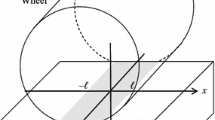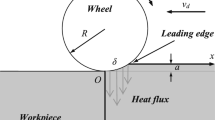Abstract
We consider the heat transfer in surface wet grinding, assuming a constant heat-transfer coefficient over the workpiece surface, as well as the usual heat flux profiles entering into the workpiece given in the literature, i.e. constant, linear, parabolic and triangular. On the one hand, we calculate in the stationary regime, the temperature distribution on the workpiece surface in series form. These series converge only for Biot numbers less than unity. By using convergence acceleration, these series can be computed more rapidly than its equivalent integral form without any appreciable loss of accuracy. Also, we avoid the numerical integration problems found in the expressions given in the literature. Moreover, the expressions found can be used to compute the maximum temperature of the workpiece very rapidly. On the other hand, we have refined some approximations for the relaxation time in wet grinding, and we have derived some new expressions for dry grinding. The relaxation time has been applied to compute the temperature field inside the workpiece in the stationary regime, obtaining a more rapid numerical evaluation without any appreciable loss of precision.




Similar content being viewed by others
References
Malkin S, Guo C (2008) Grinding technology: theory and application of machining with abrasives. Industrial Press Inc., New York
Guo C, Malkin S (1995) Analysis of energy partition in grinding. J Eng Ind 117(1):55
Malkin S, Anderson R (1974) Thermal aspects of grinding: part 1 energy partition. J Eng Ind 96(4):1177
Lavine A, von Turkovich B (1991) Thermal aspects of grinding: the effect of heat generation at the shear planes. CIRP Ann Manuf Technol 40(1):343
Lavine A (2000) An exact solution for surface temperature in down grinding. Int J Heat Mass Transf 43(24):4447
Jaeger J (1942) Moving sources of heat and the temperature of sliding contacts. Proc R Soc NSW 76(76):203–224
DesRuisseaux N, Zerkle R (1970) Temperature in semi-infinite and cylindrical bodies subjected to moving heat sources and surface cooling. J Heat Transf 92(3):456
Jaeger J, Carslaw H (1988) Conduction of heat in solids. Clarendon, Oxford
Lavine A, Malkin S, Jen T (1989) Thermal aspects of grinding with CBN wheels. CIRP Ann Manuf Technol 38(1):557
Sauer W (1971) Thermal aspects of grinding. Ph.D. thesis, Carnegie-Mellon University
Guo C, Wu Y, Varghese V, Malkin S (1999) Temperatures and energy partition for grinding with vitrified CBN wheels. CIRP Ann Manuf Technol 48(1):247
Anderson D, Warkentin A, Bauer R (2008) Experimental validation of numerical thermal models for dry grinding. J Mater Process Technol 204(1–3):269
Mahdi M, Zhang L (1998) Applied mechanics in grinding VI. Residual stresses and surface hardening by coupled thermo-plasticity and phase transformation. Int J Mach Tool Manuf 38(10–11):1289
Zarudi I, Zhang L (2002) A revisit to some wheel–workpiece interaction problems in surface grinding. Int J Mach Tool Manuf 42(8):905
Rowe W, Black S, Mills B, Qi H, Morgan M (1995) Experimental investigation of heat transfer in grinding. CIRP Ann Manuf Technol 44(1):329
Brosse A, Naisson P, Hamdi H, Bergheau J (2008) Temperature measurement and heat flux characterization in grinding using thermography. J Mater Process Technol 201(1–3):590
González-Santander JL (2016) Maximum temperature and relaxation time in wet surface grinding for a general heat flux profile. Math Probl Eng 2016:5387612
González-Santander JL, Martín G (2015) A theorem for finding maximum temperature in wet grinding. Math Probl Eng 2015:150493
González-Santander J, Martín G (2015) Closed form expression for the surface temperature in wet grinding: application to maximum temperature evaluation. J Eng Math 90(1):173
Cohen H, Villegas F, Zagier D (2000) Convergence acceleration of alternating series. Exp Math 9(1):3
González-Santander JL (2017) Efficient series expansions of the temperature field in dry surface grinding for usual heat flux profiles. Math Probl Eng 2017:1856523
Oldham K, Myland J, Spanier J (2010) An atlas of functions: with equator, the atlas function calculator. Springer, Berlin
Olver F, Lozier D, Boisvert R, Clark C (2010) NIST handbook of mathematical functions hardback and CD-ROM. Cambridge University Press, Cambridge
González-Santander J (2014) Calculation of an integral arising in dry flat grinding for a general heat flux profile. Application to maximum temperature evaluation. J Eng Math 88(1):137
González-Santander J (2016) Analytic solution for maximum temperature during cut in and cut out in surface dry grinding. Appl Math Model 40(3):2356
Murav’ev V, Yakimov A, Chernyshev A (2003) Effect of deformation, welding, and electrocontact heating on the properties of titanium alloy VT20 in pressed and welded structures. Met Sci Heat Treat 45(11–12):419
Skuratov D, Ratis Y, Selezneva I, Pérez J, Fernández de Córdoba P, Urchueguía J (2007) Mathematical modelling and analytical solution for workpiece temperature in grinding. Appl Math Model 31(6):1039
Yasui H (1983) Influence of fluid type on wet grinding temperature. Bull Jpn Soc Precis Eng 17(2):133
Suhadolnik A (2012) Appl Math Lett 25(11):1755
Hoffman J, Frankel S (2001) Numerical methods for engineers and scientists. CRC Press, Boca Raton
González-Santander J, Martín G (2014) Numerical methods for engineers and scientists. Math Method Appl Sci 37(18):2906
González-Santander J, Espinós-Morató H (2018) Depth of thermal penetration in straight grinding. Int J Adv Manuf Technol 96(9–12):3175
Lebedev N (1965) Special functions and their applications. Prentice-Hall Inc., Upper Saddle River
Apostol T (1967) Calculus, 2nd edn. Wiley, New York
Gradsthteyn I, Ryzhik M (2007) Numerical methods for engineers and scientists, 7th edn. Academic Press Inc, Cambridge
Author information
Authors and Affiliations
Corresponding author
Additional information
Publisher's Note
Springer Nature remains neutral with regard to jurisdictional claims in published maps and institutional affiliations.
Appendices
Appendix A: A useful expansion
The \(w\left( z\right) \) function is an entire function defined as [23, Eq. 7.2.3]
This function has the following expansion [23, Eq. 7.6.3]
Therefore, taking \(z=\mathrm{i}x\) in (98) and (99), and equating both results, we obtain
Notice that from (100), we have
Now, using the fact that \(\varGamma \left( \frac{1}{2}\right) =\sqrt{\pi }\) [23, Eq. 5.4.6], we finally arrive at
Appendix B: The \(\mathrm {Yu}\left( x\right) \) function
Let us define the function, \(\forall m=0,1,2,\ldots \)
To calculate the above integral (103), we use the following result [24]
where the following polynomials in 1 / x have been defined:
and
Also, the integration constant is set as
\(\forall x>0\), it is clear that we can drop the absolute value bars in (103), and thus
Also, \(\forall x<0\), we can replace the absolute value bars by a “−” sign, so that by performing the change \(t=-\tau \), we arrive at
Then, from (104), (108) and (109), and using the property \(x=\mathrm {sgn}\left( x\right) \left| x\right| \), it is easy to verify that \(\forall x\ne 0\)
Now, taking limits in (103) as \(x\rightarrow 0\), we have
\(\forall \nu \ne 0\), we can use the limiting form [23, Eq. 10.30.2]
thus, using the definition of the lower incomplete gamma function \( \gamma \left( a,z\right) \) [23, Eq. 8.2.1], we arrive at
\(\forall \nu =0\), we can use the limiting form [33, Eq. 5.16.4]
thus
Splitting (115) in two terms, on the one hand, we have
On the other hand,
where, according to [33, Eq. 1.3.19], the first integral of (117) is just \(-\gamma \), and the second integral can be integrated by parts, obtaining
where we have applied the definition of the upper incomplete gamma function \(\varGamma \left( a,x\right) \) [23, Eq. 8.2.2]. Inserting in ( 115) the results (116) and (118), we get
Using the limiting form [22, Eq. 45:3:2]
we finally conclude that
Therefore, collecting the results (110), (113) and (121), we have
where we have set
Notice that we can drop the integration constant \(A_{m,\nu }^{+}\) if we are integrating in a definite interval \(\left( a,b\right) \). Thereby, if we define the function
then
1.1 Appendix B.1: Convergence condition for \({\mathcal {T}}^{\left( k\right) }\left( X,0\right) \)
To see that the series given in (29) for \({\mathcal {T}} ^{\left( k\right) }\left( X,0\right) \) converges if and only if \(\mathrm {Bi\, }<1\), it suffices to prove the following theorem, recalling that we are considering \(\mathrm {Bi\,}\ge 0\):
Theorem 1
The alternating series
converges if and only if \(\mathrm {Bi\,}<1\).
Proof
First, we prove the necessary condition. According to [34, theorem 10.6], if a series \(\sum _{n=0}^{\infty }a_{n}\) converges, then \( \underset{n\rightarrow \infty }{\lim }a_{n}=0\). Therefore, the series given in (126), converges if
Notice that, according to (125),
and, according to [23, Eq. 10.41.2],
and thus,
where \(\gamma \left( a,x\right) \) denotes the lower incomplete gamma function [23, Eq. 8.2.1]. Notice as well that, according to Stirling’s formula [23, Eq. 5.11.3],
so that, applying the duplication formula [23, Eq. 5.5.5],
we obtain the following asymptotic formula:
Therefore, from (130) and (133), we have
Therefore, taking \(\nu =n/2\) in (134), we may calculate the following limit as
Thus, the convergence condition (127) is satisfied when \( \mathrm {Bi}<1\), as we wanted to prove.
Next, we prove the sufficient condition. Note that (126) is an alternating series, and thus,
According to (125), we have
where we have set the finite bound
Applying the following integral \(\forall \mu =\nu \) [35, Eq. 6.561.16],
we obtain
Inserting (140) in (136), we arrive at
which converges if \(\mathrm {Bi}<1\), as we wanted to prove. \(\square \)
Appendix C: The Lambert W function
In order to solve x from
power to a / b both sides and multiply the resulting equation by a / b to obtain
Performing the change \(z=\frac{a}{b}x^{a}\), we have
Knowing that the Lambert W function is the inverse function of \( \mathrm{e}^{z}z\) [23, Sect. 4.13], we solve the above equation as
and hence, undoing the change that was performed, we finally obtain
Rights and permissions
About this article
Cite this article
González-Santander, J.L., Monreal, L. Efficient temperature field evaluation in wet surface grinding for arbitrary heat flux profile. J Eng Math 116, 101–122 (2019). https://doi.org/10.1007/s10665-019-10004-y
Received:
Accepted:
Published:
Issue Date:
DOI: https://doi.org/10.1007/s10665-019-10004-y




